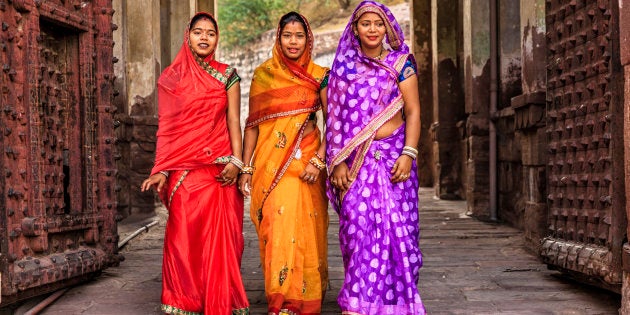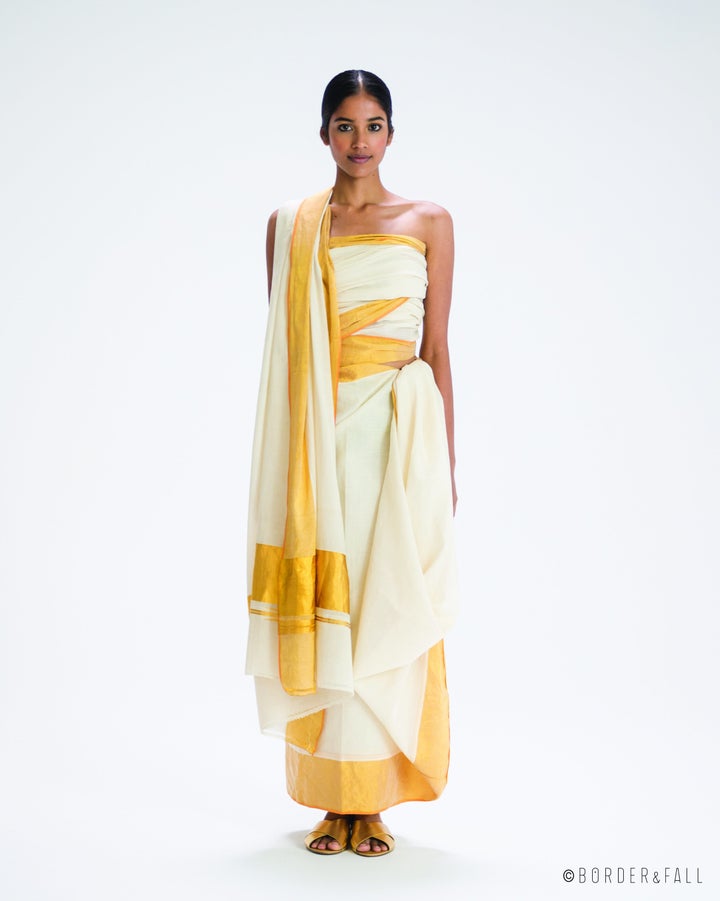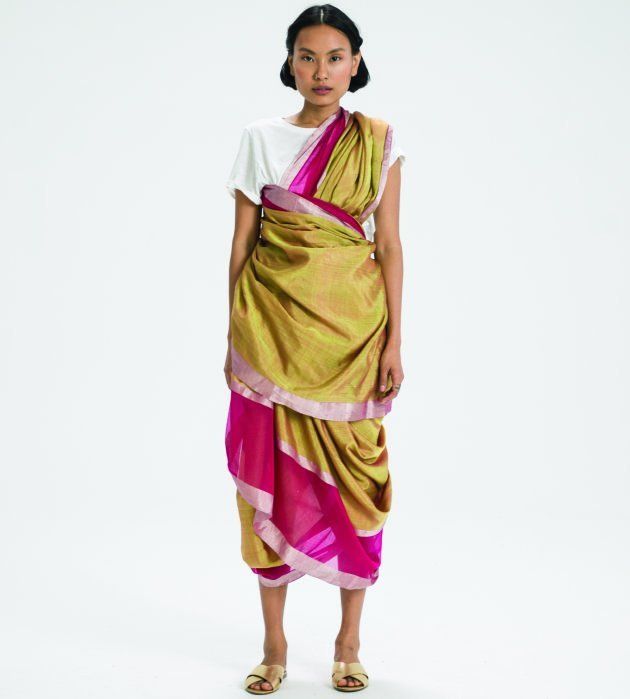
If there is one delightful memory that ties several Indian women together, it has to be of the time they tried to drape the sari all by themselves, the first time. From the pallu turning out to be the length of a kitchen towel or trailing all over the room, to the pleats constantly slipping out from between the fingers, we all have our own hilarious sari rookie stories.
Colloquially referred to as the 'nivi' by some -- nivi meaning 'new' -- this one drape with the pallu thrown over the left shoulder is the most popular drape in India.
Though that is the most familiar drape to us, there are over a hundred different ways of wearing the sari across India. Textiles scholar Rita Kapur Chishti, who has documented at least 108 styles in her book The Saris of India, notes that there is no "one type" of sari. "The sari is not only known by different names (Lugda, Dhoti, Pata, Seere, Sadlo, Kapad) in various parts of the country, it is also conceived differently in form and structure, in usage and custom," Chishti writes in the book. So how did the nivi become the default draping style?
The story starts sometime in the 1860s with a woman from Kolkata.
The story starts sometime in the 1860s with a woman from Kolkata. Several scholars have pointed out that first recorded instance of the nivi drape is attributed to Gyanodanandini Devi, the wife of Rabindranath Tagore's elder brother Satyanendranath Tagore. Devi adopted the style in the mid-1860s after accompanying her husband, who was a civil servant, to his new posting in the Bombay Presidency. Here, inspired by Parsi women, Devi began wearing a tailored blouse and petticoat with the sari. According to Chishti, she also lengthened the traditional five-yard Bengali sari to almost six yards and draped it over her left shoulder to keep her right arm free.
Traditionally, Bengali women wore saris without any blouses, with women from upper middle class families draping a chadar over their shoulders when they stepped outside their homes. This new drape was considered to be more 'modest' and suitable for moving around in public spaces.
When Devi returned to Kolkata, this style began be known as the 'Bombay Dastur' in the Tagore household and came to be adopted by all the ladies of the families. She even taught this style of wearing the sari to other women outside the family.
According to Chishti, the nivi drape became so popular because it was considered "modern". "Gyanonandini Tagore returned with this yard longer sari from Mumbai, thrown over the left shoulder to Kolkata. She then opened a school for ladies who wanted to go out and the drape became increasingly identified with the upper class Bengali bhadralok community," Chishti says. "With the introduction of the petticoat, it was not necessarily more convenient than any other style. Yet, the growing urban middle class and the increasing participation of women in the freedom movement contributed to its growing presence as a symbol of urbanisation and modernity."
The nivi drape took on political dimensions after women participating in the nationalist movement started wearing it.
"The most significant aspect, though, was that the nivi-drape, while Hindu in character, was free of any regional characteristics," researcher Rachel Tu writes in the book The Fabric of Cultures: Fashion, Identity and Globalization. "This style, wholly modern yet distinctly India, therefore became synonymous with Indian national fashion."
In the book The Sari, Mukulika Banerjee and Daniel Miller talk about how the nivi drape took on political dimensions after numerous women participating in the nationalist movement started wearing it. By the mid-1930s, the nivi style began to be seen in Indian films. Mukulika Banerjee writes that the nivi drape is not related to any particular region, but instead a sort of pan-Indian garment whose appeal has been reinforced by film stars and Indira Gandhi.

"Even in small towns, the nivi drape has become customary," says Chishti, who also runs The Sari School in Delhi to teach different ways of wearing the sari. "It is a way of going up the social ladder, moving away from wherever one came from, with its sense of identity and origins. Now that one has come full circle in terms of fashion as a personal statement, the sari is being seen as a versatile garment, capable of constant recreation. "

In 2016, a survey by Border&Fall revealed that as many as 98 percent of people thought that there were less than 15 draping styles in India. The results led to their project The Sari Series, which is creating a series of short films on 84 regional sari drapes across India. "During the project, I was amazed at the transformative nature of the sari. its continuing appeal," says Malika Verma Kashyap, founder, Border&Fall. "Yet, we tend to impose rigidity on the way to wear a saree."

Recently released as part of Google Arts & Culture's #WeWearCulture project, a set of 60 images from The Sari Series offer glimpses of these unusual draping styles across 15 Indian states. Some styles, such as the Adivasi drape from Kerala and the Dhokna Jalpaiguri drape from Bengal are traditionally worn without a blouse, while others like the Warli drape from Maharashtra and the Dharampur drape of Gujarat were considerably shorter than the nivi. Later this year, Border & Fall will release 84 short films on different regional drapes.
"In the last decade, while we have experimented with the blouse and textiles of the sari but the drape has remained quite static in Bollywood and in urban India," Verma says. "Can we take another look at a garment that is looked at as staid and traditional and occasion wear? We have a whole bunch of drapes that are relevant to today."
You can view Border & Fall's The Sari Series here.